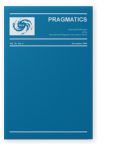Vernacular style writing
Strategic blurring of the boundary between spoken and written discourse in Japanese
This paper shows that some Japanese non-fiction writers are using various structural characteristics of spoken discourse in their writing. Their written discourse includes non-canonical word order and long sentences that are produced by combining a series of clauses. Their sentences may lack case or topic marking particles, but they may contain clause-final particles. Their discourse looks like it may have gone through a dynamic, on-going formation process because it includes reformulation and changes in the structure in midstream.
It is proposed that writers who adopt such an approach are deliberately blurring the boundary between speech and writing for multiple reasons. They may be exhibiting their creativity and innovation as well as their anti-establishment ideology. Vernacular style writing may also be an attempt to engage, involve, and connect with their readers. Further, they may be reflecting as well as expressing contemporary society in which orality is viewed favorably and as a result, writing in general has become increasingly more casual than before. The phenomenon discussed in this paper may be viewed as a reflection of erosions and shifting of traditional genres.
References (37)
Banfield, Ann
(
1982)
Unspeakable sentences: Narration and representation in the language of fiction. Boston, London, Melbourne and Henley: Routledge and Kegan Paul.

Briggs, Charles, and Richard Bauman
(
1992)
Genre, intertextuality, and social power.
Journal of Linguistic Anthropology 2.2: 131-172.


Chafe, Wallace L
(
1982)
Integration and involvement in speaking, writing, and oral literature. In
Deborah Tannen (ed.),
Spoken and written language: Exploring orality and Literacy . Norwood, NJ.: Ablex, pp. 35-53.

Clancy, Patricia M
(
1982)
Written and spoken style in Japanese narratives. In
Deborah Tannen (ed.),
Spoken and written language: Exploring orality and literacy . Norwood, NJ.: Ablex, pp. 55-76.

Frank, Jane
(
1989)
On conversational involvement by mail: The use of questions in direct sales letters.
Text 9.2: 231-259.


Hudson, Mutsuko Endo
(
2007)
Presence and absence of case markers in Japanese informal interviews. A paper presented at the 10th International Pragmatics Conference, Göteborg, Sweden, July 8-13, 2007.
Inoue, Miyako
(
2006)
Vicarious language: Gender and linguistic modernity in Japan. Berkeley, Los Angeles and London: University of California Press.


Iwasaki, Shoichi, and Tsuyoshi Ono
(
2001)
“Sentence” in spontaneous spoken Japanese discourse. In
Joan Bybee, and
Michael Noonan (eds.),
Complex sentences in grammar and discourse: Essays in honor of Sandra A. Thompson.Amsterdam and Philadelphia: John Benjamins Publishing Company, pp. 175-202.


Katsuno, Hirofumi, and Christine R. Yano
(
2002)
Face to face: On-line subjectivity in contemporary Japan.
Asian Studies Review 26.2: 205-226.


Kuno, Susumu
(
1973)
The Structure of the Japanese language. Cambridge, MA.: The MIT Press.

Kuno, Susumu
(
1978)
Japanese: A characteristic OV language. In
W.P. Lehmann (ed.),
Syntactic typology: Studies in the phenomenology of language.Austin: University of Texas Press, pp. 57-138.

Lakoff, Robin T
(
1982)
Some of my favorite writers are literate: The mingling of oral and literate strategies in written communication. In
Deborah Tannen (ed.),
Spoken and written language: Exploring orality and literacy.Norwood, NJ.: Ablex, pp. 239-260.

Lee, Kiri
(
2002)
Nominative case-marker deletion in spoken Japanese: An analysis from the perspective of information structure.
Journal of Pragmatics 34.6: 683-709.


Maynard, Senko K
(
1989)
Japanese conversation: Self-contextualization through structure and interactional management. Norwood, NJ.: Ablex.

Ono, Tsuyoshi, and Ryoko Suzuki
(
1992)
Word order variability in Japanese conversation: Motivations and grammaticization.
Text12.3: 429-455.


Ono, Tsuyoshi, and Sandra A. Thompson
(
2003)
Japanese (w)atashi/ore/boku ‘I’: They’re not just pronouns.
Cognitive Linguistics 14.4: 321-347.


Saito, Minako
(
2002)
Bunshoo tokukon san e. Chikuma-shobo: Tokyo.

Shibatani, Masayoshi
(
1999)
The languages of Japan. Cambridge: Cambridge University Press.

Stoll, Pamela
(
1998)
Text as conversation: An interpretive investigation of utterances in a women’s magazine.
Journal of Pragmatics 291: 545-570.


Suzuki, Satoko
(
1995)
The functions of topic-encoding zero-marked phrases: A study of the interaction among topic-encoding phrases in Japanese." Journal of Pragmatics 231: 607-626.


Traugott, Elizabeth Closs
(
2003)
From subjectification to intersubjectification. In
Raymond Hickey (ed.),
Motives for language change. Cambridge: Cambridge University Press, pp. 124-139.


Tsutsui, Michio
(
1984)
Wa no shōryaku.
Gengo 13.5: 112-121.

Ueno, Chizuko
(
2000)
Ueno Chizuko ga bungaku o shakaigaku suru. Asahishinbun-sha: Tokyo.

Wetzel, Patricia J
(
2004)
Keigo in Modern Japan: Polite language from Meiji to the present. Honolulu: University of Hawai’i Press.


Aoyama, Minami
1998 Ki ni naru kotoba, ki ga chiru hibi. Hon no zasshi-sha: Tokyo.

Fushimi, Noriaki
1998 [1991]
Puraibēto gei raifu. Gakuyo-shobo: Tokyo.

Haruka, Yoko
2003 Hai buriddo ūman. Kodan-sha: Tokyo.

Hashimoto, Osamu
1986 Hasu to katana. Kawaide-shoboo: Tokyo.

Hisada, Megumi
2002 Kazoku o sotsugyō shimasu. Chikuma-shobo: Tokyo.

Ito, Hiromi
2004 Onaka hoppe oshiri tome. PHP Kenkyu-jo: Tokyo.

Saito, Minako
2002 Bunshō tokukon san e. Chikuma-shobo: Tokyo.

Sano, Yoko
1985 Ganbarimasen. Shincho-sha: Tokyo.

Taguchi, Randy
2000 Dekireba mukatsukazu ni ikitai. Shincho-sha: Tokyo.

Yamamoto, Fumio
1995 Zettai nakanai. Kadokawa-shoten: Tokyo.

Cited by (3)
Cited by 3 other publications
Robertson, Wesley Cooper
2022.
Register phenomena as international news: risk, register, and translation in Japanese coverage of quotes from the 2020 US presidential debate.
Continuum 36:3
► pp. 448 ff.

Suzuki, Satoko
2022.
Connection and emotion.
Pragmatics. Quarterly Publication of the International Pragmatics Association (IPrA) ► pp. 147 ff.

Matsumoto, Yoshiko
2021.
Flexibility and fluidity of grammar: Grammatical constructions in discourse and sociocultural context.
Journal of Pragmatics 172
► pp. 105 ff.

This list is based on CrossRef data as of 15 july 2024. Please note that it may not be complete. Sources presented here have been supplied by the respective publishers.
Any errors therein should be reported to them.
